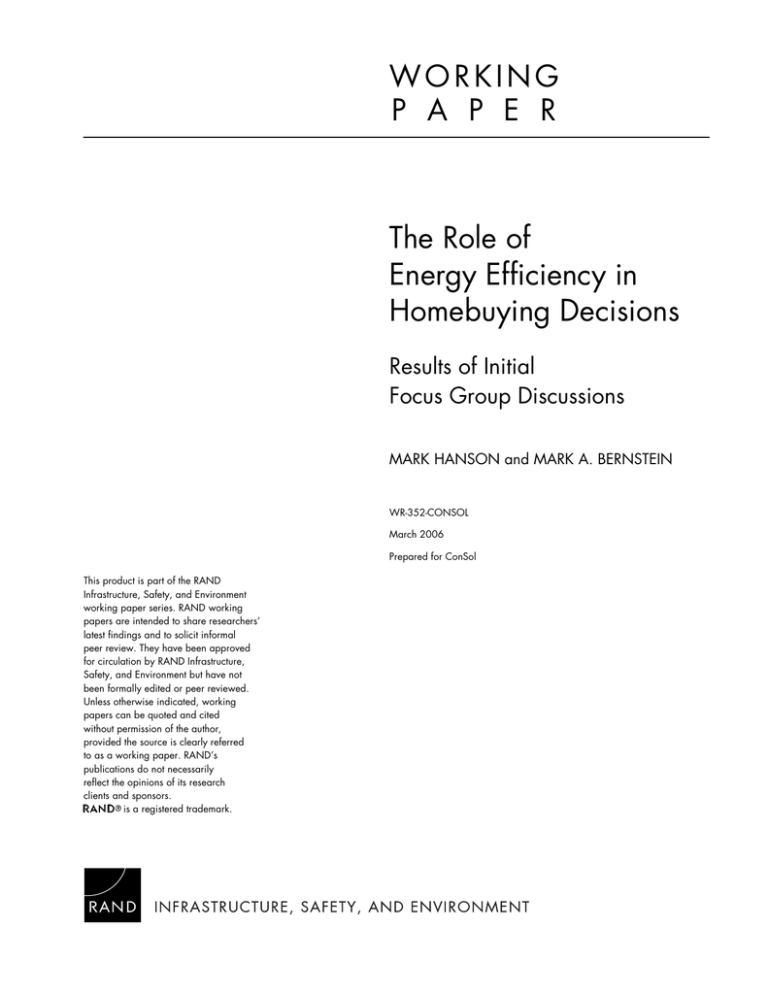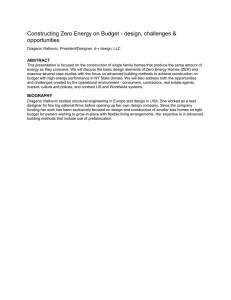W O R K I N G The Role of
advertisement

WORKING P A P E R The Role of Energy Efficiency in Homebuying Decisions Results of Initial Focus Group Discussions MARK HANSON and MARK A. BERNSTEIN WR-352-CONSOL March 2006 Prepared for ConSol This product is part of the RAND Infrastructure, Safety, and Environment working paper series. RAND working papers are intended to share researchers’ latest findings and to solicit informal peer review. They have been approved for circulation by RAND Infrastructure, Safety, and Environment but have not been formally edited or peer reviewed. Unless otherwise indicated, working papers can be quoted and cited without permission of the author, provided the source is clearly referred to as a working paper. RAND’s publications do not necessarily reflect the opinions of its research clients and sponsors. is a registered trademark. Summary Various government agencies, advocacy groups, researchers, and homebuilders have struggled to understand what role, if any, energy efficiency plays in homepurchase decisions, and how to make energy-efficient homes more attractive to consumers. Overview In 2004–05, Premier Homes and Cresleigh Homes built and sold 95 and 98 new homes, respectively, on a shared tract of land outside Sacramento, California. Most homeowners were able to choose from comparable homes from either builder. The two groups of homes themselves differ most in their levels of energy efficiency. Both homes have several energy-efficient modifications, including denser insulation, low-emissivity windows, etc. Importantly, the Premier homes have rooftop solar panels and tankless water heaters, while the Cresleigh homes do not. The Cresleigh homes were certified by the local utility, the Sacramento Municipal Utility District (SMUD) as performing approximately 30 percent more efficiently to cool than homes built to California’s “Title 24” energy standard. The Premier homes were certified to perform 60 percent more efficiently than homes built to California’s Title 24 energy standard. The Premier homes are also considered “Zero Energy Homes” (ZEH), according to the U.S. Department of Energy’s Building America program. In this report, we identify Premier Homes products as ZEH homes, their owners in our sample as ZEH homeowners, Cresleigh Homes as non-ZEH homes and their owners as non-ZEH homeowners. In a series of focus group discussions with owners of these homes conducted in October 2005, we gathered information on how these two groups of homeowners made their recent purchase decisions, the influence of builders and others on their decision, and the role energy efficiency has played in their homeownership experience more broadly. In our analysis, we explored potential differences in the ZEH and non-ZEH homeowners’ preferences at the time of their purchases, and what may account for these differences. Because variability in decision factors other than energy efficiency have been minimized in this arrangement of homes, we regard differences among statements of homeowners in these two v groups to yield potentially important insights into how consumers considered energy efficiency among many other considerations. Study Area and Sample The 193 homes in our study area (95 and 98 homes, respectively, in ZEH and non-ZEH home developments in the shared tract) share the same streets and are served by the same amenities in the surrounding community. The homes appear to be relatively more affordable by comparison to the rest of the state, yet more expensive, on average, than those in the surrounding areas. Participants in our study included 24 ZEH homeowners and 6 non-ZEH homeowners, together representing 16 percent of all households in the study area. Participants were recruited through mailings to all homes in the tract and screened by phone to verify their eligibility to participate in our study. The homeowners in our sample were well-educated and relatively high incomeearners. ZEH homeowners reported owning more homes in the past, having higher educational attainment, and engaging in a more thorough and discerning search for a home than did non-ZEH homeowners. Non-ZEH homeowners in our sample reported earning higher incomes and having larger households to satisfy. Findings Given the limitations of the research approach, the results presented in this Working Paper should be considered as preliminary. Among concerns for our approach are the small sample size and self-selection of our sample, the reliability issues of post-decision interviewing, whether homeowners in our study area represent homeowners in other communities, and whether our interpretation of their views represent energy-efficiency considerations more broadly. Nonetheless, our findings in many ways corroborate evidence reported elsewhere in the literature. Moreover, they indicate promising new lines of inquiry and hypotheses that can be more rigorously tested in further research efforts. This report is intended to share preliminary findings, invite comment and discussion among the energy-efficiency research community, and continue progress made on better understanding the issues surrounding homebuying decisions. vi Considerations in Home Purchase Decisions Homebuyers in our sample engaged in a complicated decision process involving lifestyle considerations, real estate market pressures, and financing and timing constraints, as well as different preferences for energy cost savings and comfort amenities. Where these values appeared to separate most clearly among ZEH and non-ZEH homeowners was in an apparent trade-off between potential energy savings and floor area of available homes. The Builder’s Role in Home Purchase Decisions According to the participants in our discussions, energy-efficiency information was relatively incoherent in its presentation by builders’ sales staff to homeowners before the sale. While materials that described the energy-efficiency merits of these homes (e.g., potential for energy cost savings) were available from the utility, this information was seldom presented in a manner that may have influenced the purchase decisions. The potential for energy-efficiency considerations to influence the decisions appeared to depend largely on homeowners’ prior knowledge regarding energy efficiency, which in the case of the non-ZEH homeowners in our sample appeared to be less than that of ZEH homeowners. Homeownership Experience and Energy Efficiency The experiences in their current and past homes varied among the ZEH and nonZEH homeowners in our sample. For all homeowners in our sample, home size mattered and more was generally preferred, just as national surveys report. But to ZEH homeowners, energy efficiency appears to have mattered more at the time of their recent purchases. The preference for energy efficiency among ZEH homeowners appears to be associated with relatively greater awareness of its value, despite an apparent lack of effort by the builder to promote this feature. While the decision to purchase a larger non-ZEH home may be associated with higher income and larger households, awareness of the value of energy efficiency in non-ZEH homeowners appeared to have grown over the past year of homeownership, having been associated with paying energy bills and communications with ZEH homeowner neighbors whose bills are substantially lower. vii Options for Further Research Homebuying decisions are complex. Research on homebuyer response to Zero Energy Homes is limited. Encouraging consumer demand for energy efficiency remains a challenge. Further research is needed and our findings suggest at least three promising lines of inquiry: (1) mixed-method approaches to understanding consumer valuation of energy efficiency in home purchase decisions; (2) exploring “comfort” and “quality” associations with energy efficiency for their marketing potential; and (3) investigating the impact of neighborhood design on homeowner’s attitudes toward energy efficiency of their homes, and future home purchases. Research on Homebuyer Decisionmaking We recommend further research efforts that employ interviews with builders, focus group discussions with homeowners, and also survey and econometric methods, together to triangulate information on homebuyer decisionmaking. A systematic, qualitative approach that considers decisions in “story-based” terms, in combination with consumer surveys that assess more rigorously the various decision elements along with econometric analyses that validate them in the actual purchases, may better inform our understanding of complex consumer preferences. Open questions remain: x How do homebuyers value energy efficiency among myriad other considerations when purchasing a home? x Under what conditions does the value of energy efficiency increase in relation to other decision elements, and reveal itself in actual purchase decisions? x Can a more persuasive “story” motivate consumer demand for energy efficiency? Research on Marketing Energy Efficiency Saving money on energy use appeals to homeowners, yet convincing homeowners to pay up-front for savings in the future remains a tough sell. In other words, home features that promise “comfort” or “quality” often have greater appeal to homebuyers than features that promise “energy efficiency.” However, builders and homeowners name several amenities that serve multiple purposes including energy efficiency (e.g., multi-zone HVAC systems that better moderate temperatures, trellises and gazebos that can support solar panels, and viii low-emissivity windows that protect furnishings from sun damage). The potential for cross-selling energy-efficient “options” according to their promise of comfort and quality remains open. To this end, further research can address the following questions: x What are the comfort and quality dimensions of various energy-efficient home features? x What are proven strategies for marketing these energy-efficient features, according to their comfort and quality dimensions? x What have we learned from the Energy Star labeling program experience for appliances that is relevant to new home construction and sales? In addition, builders are required to initiate homeowner associations in new subdivisions. Yet the potential for builders and utilities to incorporate rewards for energy-efficient behaviors into more formal agreements (i.e., through covenants, codes, and restrictions) appears to be untapped. Local utilities might be involved, for example, in rewarding neighborhood communities that committed to certain energy-efficiency innovations. Potential homebuyers might find such neighborhoods attractive. Open questions remain: x How might builders and utilities coordinate interests through the development of homeowner associations? x How might homebuyers respond to such programs? Research on Energy Awareness in Neighborhoods Our findings suggest that interactions among neighbors may have special relevance for encouraging preferences for energy efficiency. The mix of ZEH and non-ZEH homes in our study area may be related to the growing awareness in the non-ZEH homeowners. If this is the case, neighborhood design that incorporates this may achieve greater energy awareness in the long term, increase demand for energy efficiency in future markets for new homes, and have important implications for builders’ strategy as well. This line of inquiry may have important implications for the recently piloted Leadership in Energy and Environmental Design program’s Neighborhood Development (LEED-ND) rating system.1 Open research questions remain: _________________ 1 In partnership with the Congress for the New Urbanism and the Natural Resources Defense Council, the U.S. Green Building Council is currently piloting its LEED-ND rating system, which concerns itself with standards for environmentally sustainable building and neighborhood design. ix x Does energy awareness increase through informal, socially mediated neighborhood processes? x Does heightened energy awareness translate into energy-efficient home purchases? x How might neighborhood design facilitate greater energy awareness? x





